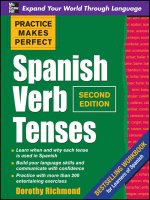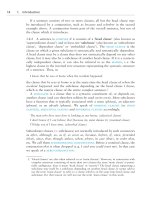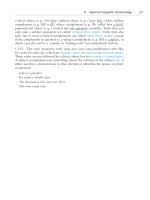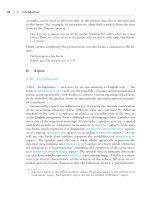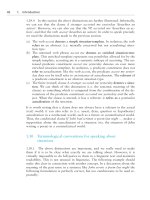English verb tenses
Bạn đang xem bản rút gọn của tài liệu. Xem và tải ngay bản đầy đủ của tài liệu tại đây (1.67 MB, 174 trang )
English Verb Tenses:
An informal but extensive reference
for ESL students, the good folks who teach them,
the idly curious, and the linguistically perplexed
by
Kent Uchiyama
copyright 2006
2
Contents
How to Use (and Not to Use) This Guide...............................................................5
The Tenses and Their Main Meanings: A Quick Overview..................................11
Which Verb Tense Should I Use? A Very Rough Guide.......................................15
Simple Present
The Basics...................................................................................................20
More That You Should know.....................................................................23
Extra Stuff...................................................................................................27
Present Progressive
The Basics...................................................................................................32
More That You Should Know.....................................................................34
Extra Stuff......................................... .........................................................39
Simple Past
The Basics...................................................................................................53
More That You Should Know....................................................................55
Past Progressive
The Basics....................................................................................................57
More That You Should Know.....................................................................59
Extra Stuff....................................................................................................62
Future
The Basics.....................................................................................................67
More That You Should Know......................................................................70
Extra Stuff......................................................................................................75
Future Progressive
The Basics......................................................................................................83
More That You Should Know........................................................................86
Extra Stuff.......................................................................................................87
Present Perfect
Introduction....................................................................................................88
A Brief Survival Guide...................................................................................90
3
Present Perfect
Meaning #1
The Basics........................................................................................................97
More That You Should Know.........................................................................98
Extra Stuff.......................................................................................................102
Meaning #1b
The Basics.......................................................................................................109
More That You Should Know........................................................................110
Extra Stuff.......................................................................................................112
Meaning #2
The Basics.......................................................................................................115
More That You Should Know........................................................................116
Extra Stuff.......................................................................................................121
Meaning #3
The Basics.....................................................................................................129
More That You Should Know......................................................................130
Some Final Points about the Present Perfect............................................................132
Present Perfect Progressive
The Basics.....................................................................................................135
More That You Should Know.......................................................................137
Past Perfect
The Basics.....................................................................................................141
More That You Should Know......................................................................143
Extra Stuff.....................................................................................................145
Past Perfect Progressive
The Basics.....................................................................................................147
More That You Should Know......................................................................150
Extra Stuff.....................................................................................................151
Future Perfect
The Basics......................................................................................................155
More That You Should Know.......................................................................157
Future Perfect Progressive
The Basics......................................................................................................159
More That You Should Know........................................................................162
Extra Stuff.......................................................................................................164
Appendix I: Questions about the Subject....................................................................167
4
Appendix II: Books and Websites You Might Find Useful...................................... ..171
A few thank-you’s..........................................................................................................174
5
How to Use (and Not to Use) This Guide
How to Use (and Not to Use) This Guide:
Some Suggestions
1. Finding the information you need
Beginning and intermediate ESL students probably won’t want to read this
book from cover to cover; it’s too much information at once. But as you’re
learning English, you’ll probably come up with a lot of questions about the verb
tenses. The purpose of this book is to help you find the answers to those
questions. This guide contains a lot of information, and so I’ve tried to make it
easy to find the information you want. Here are some steps that will help you:
1. Look in the Table of Contents (p2) for the verb tense you want.
2. Look over the Basics about that verb tense.
3. If the answer to your question isn’t in the Basics section, look in
the More That You Should Know section. You won’t have to read
everything; use the titles of each point to help you find your answer.
4. If you don’t find the answer to your question in the More That You
Should Know section, try the Extra Stuff section.
5. If you can’t find the answer to your question in this guide, see #4 below.
Important points about using verb tenses are in blue. References to other parts of
the book where you can find more information are in red.
2. What you won’t find in this guide
I only had one semester to write this guide, and so I didn’t have time to
include everything about verb forms in English. Unfortunately, you WON’T find
the following verb forms here:
*the passive
*conditionals
*modals
*reported speech
*gerunds and infinitives
*participial phrases (reduced adjective and adverb clauses)
As time goes by, I may try to add these topics to this guide. In the
6
How to Use (and Not to Use) This Guide
meantime, you can find pretty good discussions of them in many grammar texts.
I’ve listed a few texts I like on p171 in Books and Websites You Might Find
Useful.
3. If you have a question about verb tenses that isn’t answered
in this guide
Please e-mail me your question. My e-mail address is
I’ll try to include the answer in future versions of
this guide, and if I have time I’ll try to send you an answer to your question. (If
you’re a student at Chabot, please drop by my office with your question. Most
grammar questions are much easier to explain in person than by e-mail, so it can
save me a lot of time if we speak in person.)
4. What this book can and can’t do for you.
This book can (I hope)
• answer many of your questions about verb tenses, and
• explain some points about verb tenses that you won’t find in other
grammar books.
This book CANNOT take the place of a good ESL class.
Learning a language is a lot like learning how to dance; it’s almost
impossible to learn just by reading a book. When we learn to dance, nearly all of
us need to practice, interact with many different people, make mistakes, observe
what other people are doing, and learn to move easily without really thinking
about it. The same things are true when we learn a language. A well-taught ESL
class can give you all these things, but a book can’t. A book can give you a clear
understanding, but almost everyone needs more to learn how to use a language.
5. This guide probably won’t be helpful for everyone.
As I mentioned earlier, learning a language is a lot like learning to dance.
No one can learn to dance without actually dancing, and no one can learn a
language without actually using it (a lot).
However, different people learn best in different ways. When some people
7
How to Use (and Not to Use) This Guide
learn to dance, they learn more quickly and easily if someone explains the
movements to them step by step before they get on the dance floor. For other
people, explanation isn’t helpful at all. These people often learn more easily if
they just watch the dance steps for a while and then start trying them.
Similarly, some students really like detailed explanations of grammar; they
find that a clear explanation helps them learn more easily. Other students might
find that detailed explanations are frustrating or even confusing.
If you try using this guide and it isn’t helpful, it doesn’t mean that you have
a problem. You may learn better by just “jumping in” and using the language.
You might want to come back to the guide after a year or two to see if it seems
more helpful after some time has passed. Maybe it will, or maybe it won’t. The
important thing is that you find out what most helps you learn English.
6. A note for other teachers
In this guide, I’m trying to stake out some new territory, so if you
• see something that seems inaccurate,
• find an important omission, or
• have a better way to explain something,
I’d deeply appreciate hearing from you. My e-mail here at stately Chabot College
is (I’d also appreciate a heads up if you find any
typos; I’m sure there are still some lurking about.)
If you’d like to use any of the material here in your classes, feel free to do
so, but give an attribution of the source.
While we’re on the subject of using this guide, I want to stress that it’s not
written to be used as the sole ESL textbook for a grammar class. It was meant to
be a reference, so there are no exercises. Also, the sheer amount of material could
be overwhelming for many students, especially if a teacher tried to teach the book
cover-to-cover. I’ve used parts of this guide in many of my classes,
supplementing it with exercises from other sources and ones I wrote myself, and
that’s worked well. See what works for you. If you come up with a great idea
for using this guide, please let me know!
8
How to Use (and Not to Use) This Guide
7. A note for grammatical purists
In the following pages, I’ve split infinitives, ended clauses with
prepositions, used their with a singular antecedent, began sentences with
conjunctions, and used adjective clauses to modify other clauses. These practices
are not born of ignorance or a desire to annoy you; I just don’t hold much truck
with the outlook that underlies the rules I’m disregarding. However, if you are
convinced of the intellectual (or moral) superiority of schoolhouse grammar, I
doubt that I can convince you otherwise. (Years of effort have not succeeded
with my mom.) I can only extend my sincere (but more or less unrepentant)
apologies in advance, along with my honest hope that you’ll still find the
following information helpful in some way. And if you do see something that
seems to arise from my ignorance or negligence rather than my attitude, I would
deeply appreciate your correction.
9
How to Use (and Not to Use) This Guide
10
How to Use (and Not to Use) This Guide
11
The Tenses and Their Main Meanings
The Tenses and Their Main Meanings
(These are only the main meanings; for more complete
information, see the section on each tense.)
Past Tenses
Simple Past
Main Meaning
This action ended in the past.
John did his homework last night.
Note: Simple past is correct for most actions in the past. There are only a
few times when we absolutely need to use other past tenses.
Past Progressive
Main Meaning
This action happened over time in the past.
Most common use: to show this action was happening over time when
something happened.
John was doing his homework when the earthquake started.
Past Perfect
Main Meaning
We use past perfect when we want to make it clear that this action happened
before something in the past.
Norton had eaten breakfast when he left for work. (This means Norton ate
breakfast before he went to work.)
Past Perfect Progressive
Main Meaning
We use past perfect progressive when we want to make it clear that this action
was happening over time before something in the past.
The kitchen smelled wonderful because Norton had been cooking dinner.
12
The Tenses and Their Main Meanings
Present Tenses
Simple Present
Main Meanings
This action is a habit or repeated now.
I usually drive to school.
This is a fact that’s always (or almost always) true.
Wood floats in water.
Present Progressive
Main Meanings
This action is happening right now.
You are reading this sentence.
This action isn’t finished, but might not be happening right now.
John is studying English this semester, but he isn’t studying right now; he’s
eating dinner.
Note: Don’t use present progressive with stative verbs.
Present Perfect
Main Meanings
With a length of time, present perfect usually means this action started in the
past and has continued until now.
Ralph’s a bus driver. He has worked as a bus driver for 10 years.
Note: Present Perfect Progressive can often be used to say the same thing
(but not with stative verbs).
With no time phrase, present perfect usually means the action ended in the
past, but the time is not clear.
Ralph isn’t hungry because he has eaten dinner.
Note: In American English, simple past can usually be used to say the same
thing.
Present Perfect Progressive
Main Meaning
This action started in the past and has continued until now.
Ralph’s a bus driver. He has been working as a bus driver for 10 years.
Note: Don’t use present perfect progressive with stative verbs.
13
The Tenses and Their Main Meanings
Future Tenses
Future
Main Meaning
This action will happen in the future.
Ralph and Norton will play cards tomorrow night.
Note: Future is correct for most actions in the future. There are only a
few times when I absolutely need to use other future tenses.
Future Progressive
Main Meaning
This action will happen over time in the future.
Most common use: to show this action will be happening over time when
something happens.
I’ll start to study at 7:00, so I’ll be studying when you arrive at 7:`10.
Future Perfect
Main Meaning
We use future perfect when we want to make it clear that this action will happen
before something in the future.
Martha will have finished her homework when she comes to class tomorrow.
Note: If it’s already clear which action will happen first, future is also
okay.
Future Perfect Progressive
Main Meaning
This action will happen over time before something in the future
When I retire, I will have been teaching for over forty years.
Note: Future perfect progressive is a pretty rare tense; we don’t use it very
much.
14
The Tenses and Their Main Meanings
15
Which Verb Tense Should I Use?
Which Verb Tense Should I Use?
A Very Rough Guide
Actions in the Past
For most actions in the past:
simple past
I ate breakfast at 7:00 this morning before I went to work.
I’m a little tired today because I went to bed late.
When I need to make it clear that this action was in progress when
something happened:
past progressive
I was taking a bath when you called, so I couldn’t answer the phone.
When I want to show that an action started in the past and has continued
until now:
present perfect progressive (for most verbs)
I have been teaching at Chabot for fourteen years.
John has been thinking about buying a new car.
OR
present perfect + a length of time (for stative verbs)
George Bush Sr. has hated broccoli since he was a child.
When I want to show that an action happened before something in the past:
past perfect
At 5:00, Fred had finished work for the day. (This means that Fred finished
work before 5:00.)
(NOTE: We can say, At 5:00, Fred finished work for the day, but this sentence
has a different meaning. It means that Fred finished work at 5:00, not
before.)
16
Which Verb Tense Should I Use?
When I need to make it clear that this action was happening over time before
another action (or a time) in the past:
past perfect progressive (for most verbs)
Barney had been studying for six hours when he fell asleep at his desk.
OR
past perfect + a length of time (for stative verbs)
Ralph had loved Alice for many years before he asked her to marry him.
For actions that have never happened in someone’s life:
present perfect
I’ve never seen a flying elephant.
For questions asking if someone has ever done something in their life:
present perfect
Have you seen the Grand Canyon?
For repeated actions that might happen again:
present perfect
Hoku has seen that movie eight times.
17
Which Verb Tense Should I Use?
Actions in the Present
For a present habit:
simple present
I don’t drive to work; I usually take BART.
For something that is always or usually true:
simple present
Wood floats on water.
Rocks don’t float. They sink.
For an action happening right now:
present progressive (for most verbs)
Norton isn’t home now. He’s studying at the library.
OR
simple present (for stative verbs only)
Right now, I understand my calculus homework, but tomorrow I may be
confused again.
For an action that isn’t finished yet:
present progressive (for most verbs)
Martin is working at the library this semester, but he isn’t there now because
today’s Sunday and library’s closed.
18
Which Verb Tense Should I Use?
Actions in the Future
For predictions (things we think will happen):
future
Fred’s plane will arrive at 8:00.
Fred’s plane is going to arrive at 8:00.
For actions that will be happening over time when something happens:
future progressive
When Lucy’s plane arrives tomorrow, Ricky will be waiting for her at the airport.
For future plans:
be going to
Ralph and Alice are going to visit Yosemite National Park next month.
For time clauses and if-clauses in the future:
simple present (almost always)
When Ralph gets home tomorrow night, he’s going to take Alice out to dinner.
If Yoko buys a car next Friday, she’ll drive it to school on Monday.
When I need to make it clear that this action will be finished before
something in the future:
future perfect
The train always leaves at 12:00. If you get to the station at 12:05, the train will
have already left.
When I need to make it clear that this action will happen over time before
something in the future:
future perfect progressive (for most verbs)
Next September, I will have been working at Chabot for 10 years.
OR
future perfect + a length of time (for stative verbs)
At its anniversary in 2011, Chabot College will have existed for fifty years.
19
Which Verb Tense Should I Use?
20
Simple Present--The Basics
Simple Present
Part 1:
The Basics
1. What does simple present tense mean?
Usually, simple present tense means
1) that the action is a habit (or another type of repeated action)
in the present
or
2) that the action is always or usually true.
Examples:
I usually eat lunch at the school cafeteria. (This is a habit in the present.)
What time do you usually feed your pet dinosaur? (I’m asking about a
habit in the present.)
Ralph and Norton sometimes go bowling on Thursday nights. (This is a
habit in the present.)
George usually doesn’t buy bananas at Albertson’s. (This is a habit in the
present.)
Wally never comes late to class. (This is a habit in the present.)
The moon travels around the earth. (This is always or usually true.)
Wilma makes good gravelberry pies. (This is always or usually true.)
Does the sun rise in the east or in the west? (I want to know if this is
always or usually true.)
Government officials often don’t tell the truth. (This statement is usually
true.)
Simple present can also have other uses. You can find these in the points
“Stative verbs use simple present, not present progressive” on p24,
“Simple present in future time clauses and if-clauses” p25,
“Scheduled events in the future” p25, and
“Simple present when discussing literature” p26.”
21
Simple Present--The Basics
2. How do I make simple present?
Statements
1. If the subject is I, you, we, or they, use the simple form of the verb.
Examples:
I go to bed at 11:00.
You go to bed at 11:00.
We go to bed at 11:00.
George and Gracie (they) go to bed at 11:00.
I usually walk to the store.
2. If the subject is he, she, or it, add -s or -es to the simple form of the
verb.
Examples:
Ralph (he) goes to bed at 11:00.
Alice (she) goes to bed at 11:00.
Carmen’s pet elephant (it) goes to bed at 11:00.
Ahmed usually walks to the store.
Negative Statements
do/does + not + simple form.
Examples:
Americans usually do not eat soup for breakfast.
I usually don’t buy lunch on Thursdays.
John does not play tennis.
Ralph often doesn’t drive to work.
Questions1
(Question word) + do + subject + simple form
Examples:
Does your pet gorilla bite?
Do you buy your groceries at Alberstons?
What do Norton and Trixie usually do on weekends?
Where does Alice buy her groceries?
Remember : Questions that ask who did something or what did something don't
follow the normal question patterns. See “Appendix: Questions about the
Subject” on p167.
1
22
Simple Present--The Basics
Why do leaves turn brown in the autumn?
When does Ward eat dinner?
23
More...about Simple Present
Part 2:
More That You Should Know about Simple
Present
1. The verb be
The verb be in English is just plain weird. It almost never follows the same
rules as other verbs. For the verb be,
• simple present statements,
• negative statements, and
• questions
are all formed in unusual ways. Although you probably learned the information
below in one of your very first English lessons, here it is again for the sake of
completeness.
Simple Present Statements with Be
If the subject is I, use am.
Examples:
I am a teacher.
I’m often absent-minded.
I am in class every Wednesday at 10:00.
If the subject is you, we, or they, use are
Examples:
You are my sunshine, my only sunshine (from an old song).
We’re so happy that you didn’t eat our cat!
Fred and Ethyl are in the kitchen with Lucy and Ricky.
If the subject is a he, she, or it, use is.
Examples:
Arnold Schwarzenegger (he) is the governor of California. (This sentence
was true in 2005, when this guide was written. California may have
a new governor by the time you read this.)
Paris Hilton’s rich. She isn’t an English teacher.
24
More...about Simple Present
My car (it) is in the parking lot at beautiful Chabot College.
Simple Present Negative Statements with Be
Add not after be.
Examples:
I am not a millionaire or a rock star.
I’m not rich or famous.
I’m probably not in Paris Hilton’s address book.
You are not my boss, so stop telling me what to do.
Bats aren’t birds.
We’re not in Kansas any more.
George W. Bush is not my uncle.
A wet cat isn’t very happy.
It’s not cold; you don’t need to wear a coat.
Simple present questions with Be2
Put be in front of the subject
Examples:
Am I taller than your cousin in Utah?
Are George and Gracie married?
Where are my car keys?
Why is the sky blue?
2. Stative verbs use simple present, not present progressive.
Some verbs, such as want, understand, and know, don’t use present
progressive; instead, they usually use simple present even if the action is
happening right now. This point is explained more in “Stative verbs usually
don’t use present progressive” on p34.
Remember : Questions that ask who did something or what did something don't
follow the normal question patterns. See “Appendix I: Questions about the
Subject” on p167.
2
25
More...about Simple Present
3. Simple present in future time clauses and if-clauses
Future time clauses and future if-clauses (with one exception--see p73)
do not use future; instead, they use one of the present tenses, usually simple
present.
Examples:
After I will go go to the store tomorrow, I’ll give you a call.
Before Trixie will leave leaves for school next Tuesday, she’s going to do
her English
homework.
When Mohammed will get gets home tonight, he will cook dinner and then
help his kids with their homework.
If John will find finds a new job, he’s going to have a party.
I’ll be at the library tonight if you will need need to find me.
This point is explained a little more in the points
“Don’t use future in time clauses” on pp71 and
“Don’t use future in (most) future if-clauses” on p72.
We can use some other present tenses, like present progressive or present
perfect in future time clauses and if-clauses; however, these usually aren’t
necessary. You can find them explained in the points
“Present progressive in future if-clauses” p73,
“Present progressive in future time clauses” p79,
“Present perfect in future time clauses” p80, and
“Present perfect in future if-clauses” p80
4. We can use simple present for scheduled events in the future
If you want to, you can use simple present for future scheduled events
such as plane arrivals & departures, classes, and so on. You can’t do this for
most future actions; you can only do it for actions that are scheduled. It’s not
necessary to use simple present for scheduled events; the future is also okay.
Examples:
My class will start tomorrow morning at 9:00.
My class starts tomorrow morning at 9:00.
(Both sentences mean the same thing.)

